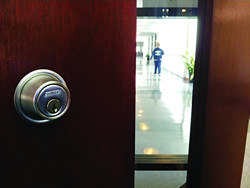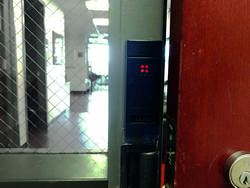University Offers Various Means for Campus Protection
 Deadbolt-style locks have been installed in Joan and Robert Rechnitz Hall and the Jules L. Plangere Center for Communication as part of an ongoing effort to increase on-campus safety and security. This precautionary step was taken, according to Patricia Swannack, Vice President for Administrative Services, to improve the time that it would take to lock a door.
Deadbolt-style locks have been installed in Joan and Robert Rechnitz Hall and the Jules L. Plangere Center for Communication as part of an ongoing effort to increase on-campus safety and security. This precautionary step was taken, according to Patricia Swannack, Vice President for Administrative Services, to improve the time that it would take to lock a door.
According to Mary Anne Nagy, Vice President for Student Life and Leadership Engagement, the deadbolt-style locks are being installed in stages due to the amount of locks that need to be put in.
Nagy said that the installation is not due to the Feb. 14 shooting in Parkland, FL, but as part of the “natural progression” of increased campus security.
“There are many different styles of locks throughout the campus, some of which can be locked with a key,” said Swannack. “It is much easier to simply flip a deadbolt from inside a classroom than to have to locate keys.”
Swannack also mentioned, that deadbolts are a cost-effective solution. A deadbolt style lock costs approximately $45 per lock and are being installed by University locksmiths and carpenters. Installation takes approximately one hour per lock.
“I feel this is safe,” said Conor Scott, a senior homeland security student. “The main thing that I can see this measure being useful for is active shooters or other shelter-in-place scenarios. If something happens that forces students and staff to hide, dead bolting classroom doors may help provide an extra level of defense from a threat outside the classroom.”
Many of the building locks have a button under the latch which, when pushed, causes the door to be locked from the inside, as opposed to a deadbolt. Once locked, a key would be needed to gain entrance, or the door would need to be opened from the inside. Buildings with these locks include the Magill Dining Hall and the offices in the James and Marlene Howard Hall, Samuel E. and Mollie Bey Hall, and the Plangere Center. Locks with a key mechanism cost the University approximately $250 each, according to Swannack.
 “I think every school, whether you’re an elementary school or a high school or a college, now you’re constantly looking at what you are doing,” Nagy said. “They’ve done a lot of things over the years to improve safety.”
“I think every school, whether you’re an elementary school or a high school or a college, now you’re constantly looking at what you are doing,” Nagy said. “They’ve done a lot of things over the years to improve safety.”
“I think this is a step in the right direction,” said Scott. “Having a deadbolt on classroom doors doesn’t pose any considerable risks that a simple lock wouldn’t present. In the event of an emergency in which students cannot safely evacuate, having an extra layer of security as simple as a deadbolt could make a difference.”
Sophomore homeland security student Alyssa Corea said that she felt the locks were a good step because she thought that many classrooms did not have locks on them in the first place.
According to Swannack, the installation of the deadbolt-style locks will not affect the historical features of Woodrow Wilson Hall and the Murry and Leonie Guggenheim Memorial Library. “[These buildings] are not exempt from complying with safety regulations,” said Swannack, who said that despite the “many different” door and lock styles in Wilson Hall, many of the rooms already have locks including a deadbolt. Campus leadership is also “evaluating steps” which can be taken to improve safety in the Thomas A. Edison Science Hall.
“We have also installed card access on many of the larger buildings on campus,” said Swannack. “This would allow the Monmouth University Police Department (MUPD) to ‘lock down’ a campus building or all buildings with card access if an emergency situation warrants such action.”
MUPD also evaluates classrooms and performs Active Shooter Trainings five times per year in locations that have included Edison Hall, residence halls, and the Lauren K. Woods Theatre.
Swannack also noted that, in addition to having “excellent relationships with the surrounding police departments, as well as Monmouth County,” the majority of MUPD officers have retired from a variety of police departments throughout the state, bringing years of experience to the campus security.
![]() “The University Police have visited many departments over the years to review with the occupant’s specifics concerns and/or remedies that can be used if, God forbid, anything ever happened,” Swannack said.
“The University Police have visited many departments over the years to review with the occupant’s specifics concerns and/or remedies that can be used if, God forbid, anything ever happened,” Swannack said.
According to Nagy, University safety measures also include phones in every classroom, a campus-wide computer application (Alertus) that allows users to send an alert to the Monmouth University Police Department (MUPD), and security cameras which are “incredibly helpful” in locations such as the underpass and the entrances and lobbies of residence halls.
According to Swannack, Alertus was purchased by the University due to difficulty in installing a campus-wide panic alarm system.
“On hard wired computers, not laptops or mobile setups, there should be a small red icon in the lower right hand corner of your monitor,” said Swannack. “The red button, if clicked, will send a silent notification to MUPD that there is an emergency situation and the person activating the alarm cannot speak openly. The system is a quick and easy way to summon help.”
According to Swannack, the system is tested every shift by MUPD officers to ensure that it is working and so that “all personnel understand what to do in the event of an emergency.” Swannack also said that the system can be activated by MUPD to send an outgoing emergency message to the campus community.
“I think Monmouth University is right to consider various means of protecting students in the event of an emergency,” said Scott. “Active shooters seem to be becoming a more common occurrence at schools across the United States. Bolstering security is a wise move on the part of the University. It is easy to become complacent and think that an active shooter scenario couldn’t happen here, but it’s best to be aware of the risks and take the necessary steps to mitigate them.”
“On a college campus it’s very tough, because we’re an open campus,” Nagy said. “At least with a high school or an elementary school, you can kind of control points of entry. Imagine trying to control the points of entry to this campus. Yet, if we had a gate completely around this campus and you only had one or two entrances… in essence, you’re walling yourself off from the community, and walling the community off from you, and I’m not sure that’s healthy on a college campus.”
Swannack said that the University’s emergency preparedness plan is reviewed and revised as necessary on an annual basis. She also asked that students do what they can to help the University protect them.
Both Swannack and Nagy strongly encourage the Monmouth community to not prop any doors open to buildings that includes residence halls. Also, the two recommend that should anyone feel uncomfortable or see something out of the ordinary to you on campus, the Graduate Center or the Lakehouse, that you immediately call the Monmouth University Police Department (MUPD) to let the officers further handle the situation.
“If you do not want to call the police, then tell a faculty member, administrative employee, or staff member, and ask them to report it,” Swannack continued. “If it is necessary for you to walk across campus late in the evening, or at any time and you are concerned for your safety, MUPD offers an escort service. Please do not hesitate to use it; it is for your protection.”
“I think that some of the best defense, from a safety and security perspective, is really each other,” said Nagy. “If people see something, they should say something. There have been times where a backpack has been left here for hours, and people will call. We’re the best ones. If we see a door that’s propped open, we make sure that door gets pulled closed and we aren’t propping open doors in the future. We are important defenses.”
To read Outlook editors’ opinions on this topic, please read the editorial “Editors Talk Campus Safety” on page four.
PHOTOS TAKEN by Alexandria Afanador
PHOTO TAKEN by Kerry Breen



